Genome-wide identification, phylogeny, duplication, and expression analyses of two-component system genes in Chinese cabbage (Brassica rapa ssp. pekinensis)
- PMID: 24585003
- PMCID: PMC4131832
- DOI: 10.1093/dnares/dsu004
Genome-wide identification, phylogeny, duplication, and expression analyses of two-component system genes in Chinese cabbage (Brassica rapa ssp. pekinensis)
Abstract
In plants, a two component system (TCS) composed of sensor histidine kinases (HKs), histidine phosphotransfer proteins (HPs), and response regulators (RRs) has been employed in cytokinin signal transduction. A TCS exhibits important functions in diverse biological processes, including plant growth, development, and response to environmental stimuli. Conducting an exhaustive search of the Chinese cabbage genome, a total of 20 HK(L) (11 HKs and 9 HKLs), 8 HP (7 authentic and 1 pseudo), and 57 RR (21 Type-A, 17 Type-B, 4 Type-C, and 15 pseudo) proteins were identified. The structures, conserved domains, and phylogenetic relationships of these protein-coding genes were analysed in detail. The duplications, evolutionary patterns, and divergence of the TCS genes were investigated. The transcription levels of TCS genes in various tissues, organs, and developmental stages were further analysed to obtain information of the functions of these genes. Cytokinin-related binding elements were found in the putative promoter regions of Type-A BrRR genes. Furthermore, gene expression patterns to adverse environmental stresses (drought and high salinity) and exogenous phytohormones (tZ and ABA) were investigated. Numerous stress-responsive candidate genes were obtained. Our systematic analyses provided insights into the characterization of the TCS genes in Chinese cabbage and basis for further functional studies of such genes.
Keywords: Chinese cabbage; evolution; expression; phylogeny; two-component system.
© The Author 2014. Published by Oxford University Press on behalf of Kazusa DNA Research Institute.
Figures
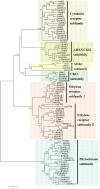
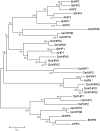



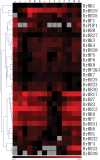
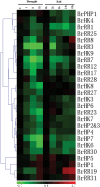
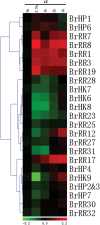
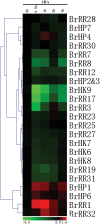
Similar articles
-
Identification, expression, and comparative genomic analysis of the IPT and CKX gene families in Chinese cabbage (Brassica rapa ssp. pekinensis).BMC Genomics. 2013 Aug 30;14:594. doi: 10.1186/1471-2164-14-594. BMC Genomics. 2013. PMID: 24001366 Free PMC article.
-
Characterization and expression profiling of MYB transcription factors against stresses and during male organ development in Chinese cabbage (Brassica rapa ssp. pekinensis).Plant Physiol Biochem. 2016 Jul;104:200-15. doi: 10.1016/j.plaphy.2016.03.021. Epub 2016 Mar 18. Plant Physiol Biochem. 2016. PMID: 27038155
-
Genome-wide analysis of the AP2/ERF transcription factor superfamily in Chinese cabbage (Brassica rapa ssp. pekinensis).BMC Genomics. 2013 Aug 23;14:573. doi: 10.1186/1471-2164-14-573. BMC Genomics. 2013. PMID: 23972083 Free PMC article.
-
Gene co-expression network analysis reveals key pathways and hub genes in Chinese cabbage (Brassica rapa L.) during vernalization.BMC Genomics. 2021 Apr 6;22(1):236. doi: 10.1186/s12864-021-07510-8. BMC Genomics. 2021. PMID: 33823810 Free PMC article. Review.
-
Shaping resilience: The critical role of plant response regulators in salinity stress.Biochim Biophys Acta Gen Subj. 2025 Feb;1869(2):130749. doi: 10.1016/j.bbagen.2024.130749. Epub 2024 Dec 22. Biochim Biophys Acta Gen Subj. 2025. PMID: 39719184 Review.
Cited by
-
Structure and character analysis of cotton response regulator genes family reveals that GhRR7 responses to draught stress.Biol Res. 2022 Aug 16;55(1):27. doi: 10.1186/s40659-022-00394-2. Biol Res. 2022. PMID: 35974357 Free PMC article.
-
Genome-wide identification and expression profile analysis of metal tolerance protein gene family in Eucalyptus grandis under metal stresses.BMC Plant Biol. 2023 May 6;23(1):240. doi: 10.1186/s12870-023-04240-9. BMC Plant Biol. 2023. PMID: 37149585 Free PMC article.
-
Genome-wide characterization of two-component system elements in barley enables the identification of grain-specific phosphorelay genes.BMC Plant Biol. 2025 Feb 17;25(1):209. doi: 10.1186/s12870-025-06161-1. BMC Plant Biol. 2025. PMID: 39962384 Free PMC article.
-
Transcriptome Profiling, Biochemical and Physiological Analyses Provide New Insights towards Drought Tolerance in Nicotiana tabacum L.Genes (Basel). 2019 Dec 15;10(12):1041. doi: 10.3390/genes10121041. Genes (Basel). 2019. PMID: 31847498 Free PMC article.
-
A multi-step phosphorelay two-component system impacts on tolerance against dehydration stress in common wheat.Funct Integr Genomics. 2014 Dec;14(4):707-16. doi: 10.1007/s10142-014-0398-8. Epub 2014 Sep 17. Funct Integr Genomics. 2014. PMID: 25228409
References
-
- Mok D.W.S., Mok M.C. Cytokinin metabolism and action. Annu Rev Plant Physiol Plant Mol Biol. 2001;52:89–118. - PubMed
-
- Yamada S., Shiro Y. Structural basis of the signal transduction in the two-component system. Adv Exp Med Biol. 2008;631:22–39. - PubMed
-
- Loomis W.F., Shaulsky G., Wang N. Histidine kinases in signal transduction pathways of eukaryotes. J Cell Sci. 1997;110:1141–5. - PubMed
-
- Schaller G.E. Histidine kinases and the role of two-component systems in plants. Adv Bot Res. 2000;32:109–48.
Publication types
MeSH terms
Substances
LinkOut - more resources
Full Text Sources
Other Literature Sources
Research Materials
Miscellaneous

